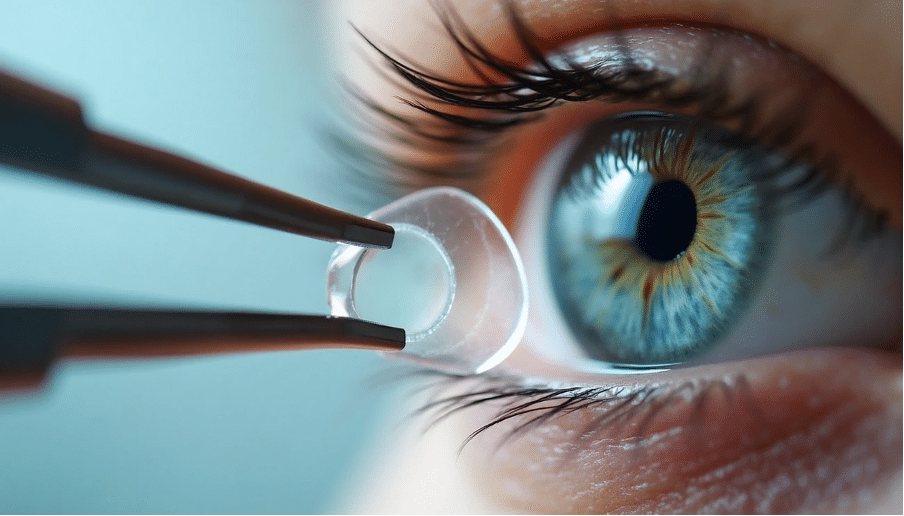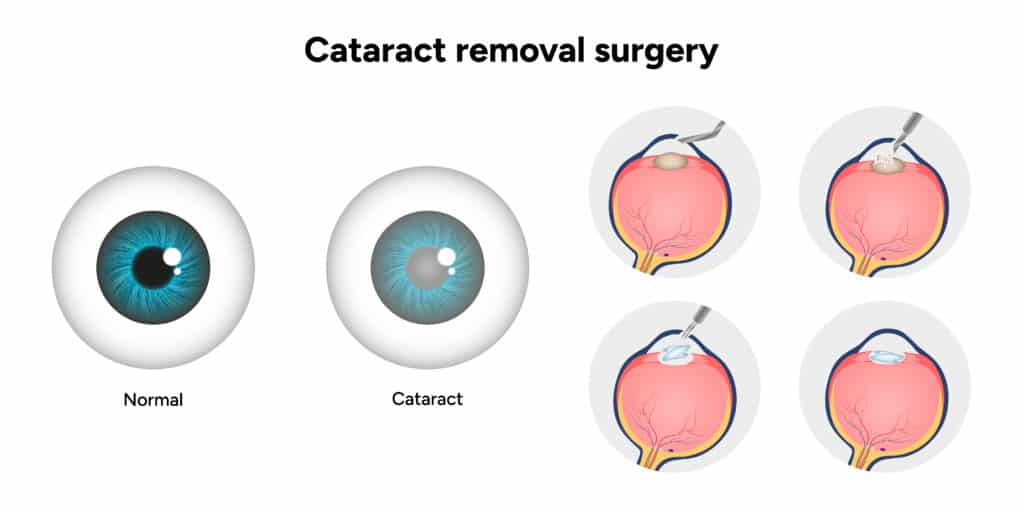The choice between Light Adjustable Lenses and Traditional IOLs can affect your vision’s outcome after cataract surgery. Cataract surgery has a success rate of around 98%, making it one of the most reliable surgical procedures accessible to more people today.
Your post-surgery visual experience depends on the lens implant you pick. Light adjustable lens technology gives you a chance to customise your lenses after surgery, unlike traditional IOLs that remain fixed during the procedure. You’re more likely to achieve 20/20 vision with adjustable lenses and might not need glasses or contacts afterward. LAL implants deliver better distance vision than traditional monofocal implants, and their precise correction ensures optimal visual acuity.
Lens replacement surgery has evolved beyond cataract removal to improve your vision’s quality. Precision Vision London’s team provides both light adjustable IOL lenses and traditional options. We help you pick the best lens implant based on your vision needs and lifestyle. This piece will show you the benefits of each approach to help you pick the right option with confidence.

Understanding Cataract Surgery and Lens Replacement
Cataract surgery stands as one of the UK’s most common surgical procedures, and with good reason too – doctors perform approximately 330,000 operations annually. This life-changing procedure has transformed over recent decades. Patients now enjoy better outcomes and can choose from various lens options.
What happens during cataract surgery?
The surgery takes between 20 to 45 minutes. Patients can return home the same day since it’s an outpatient procedure. Local anaesthetic eye drops numb the eye, which lets patients stay awake and comfortable throughout the operation.
Your surgeon creates a tiny incision in the cornea, which is the clear front surface of your eye. They use a technique called phacoemulsification. An ultrasound probe breaks up the cloudy lens into small fragments and suctions them out gently. The surgeon then places the new artificial lens through that same small incision. The incision heals naturally without stitches in most cases.

Why lens replacement is necessary
Cataracts develop as cloudy patches in your eye’s natural lens. These patches resist treatment through medication or corrective eyewear. Your lens proteins break down and clump together as you age, which causes cloudiness. Vision quality deteriorates over time, leading to blurry sight, increased light sensitivity, and eventual significant vision loss. Surgery remains the only way to remove cataracts. A clear artificial lens replaces your cloudy natural lens, which restores and often improves your vision beyond its pre-cataract quality.
Types of intraocular lenses available in the UK
UK patients can choose from several intraocular lenses (IOLs):
- Standard Monofocal IOLs: These lenses provide clear vision at one distance, usually far vision, but you’ll need reading glasses for close work. The NHS covers these most common lenses.
- Toric IOLs: These specialised lenses correct astigmatism while removing cataracts.
- Multifocal/Trifocal IOLs: These premium lenses deliver clear vision at multiple distances (near, intermediate, and far). They reduce your dependence on glasses.
- Extended Depth of Focus (EDOF) IOLs: These lenses excel at distance and intermediate vision. They work well for computer work and daily activities.
- Light Adjustable Lenses (LALs): These are the only IOLs that can be customised after surgery to achieve the best possible vision outcomes.
Precision Vision London’s consultations are a great way to get guidance on choosing the lens option that matches your lifestyle and visual needs.
How Light Adjustable Lenses and Traditional IOLs Work
These lens options differ fundamentally in their design philosophy and adjustment capabilities.
Light Adjustable Lens: UV-responsive material and post-op tuning
Light Adjustable Lenses contain special photosensitive materials (macromers) that react to controlled UV light exposure. LALs offer unique adjustability after implantation, unlike conventional lenses. Your eye needs 3-4 weeks to heal after surgery. The specialists at Precision Vision London then use a Light Delivery Device to reshape the lens based on your visual needs. This approach lets doctors fine-tune both spherical and cylindrical corrections. The lens power becomes permanent through “lock-in” treatments after achieving optimal vision.
Traditional IOLs: Fixed power and pre-surgery selection
Traditional IOLs come with a set power that stays unchanged after implantation. Doctors must take precise pre-operative measurements to calculate the right prescription. Traditional IOLs achieve about 80% accuracy within ±0.5D of the target prescription, even with advanced calculation methods. Patients often need glasses or contact lenses to correct any remaining refractive errors.
Visual outcome predictability: Adjustable vs fixed
Research shows that LAL patients have double the chance of achieving 20/20 vision without glasses compared to traditional IOL patients (70.1% vs 36.3%). LALs also show excellent refractive accuracy—92% within 0.50D of target prescription. This improved predictability makes LALs valuable for patients who have had previous refractive surgery or complex visual needs.
Comparing Visual Outcomes and Lifestyle Benefits
Light Adjustable Lenses and traditional IOLs show their differences clearly in everyday life.
Customisation: Post-surgery adjustments vs fixed prescription
LALs let doctors adjust your vision after implantation through painless UV light treatments. These 90-second procedures give you up to three adjustments based on your ground experience. Traditional IOLs stay fixed at the power chosen before surgery and don’t allow any changes.
Vision clarity: Ground testing with LALs
92% of LAL patients reach their target vision and need fewer corrective eyewear. This accuracy comes from adjustments based on actual visual experience instead of pre-surgical estimates.
Dependence on glasses: Reduced with LALs
LALs’ customisable nature helps many patients see without glasses for daily activities. Most patients using traditional IOLs still need corrective eyewear for certain tasks.
Night vision and glare: How each lens performs
LALs work like monofocal lenses in terms of optical quality and avoid extra visual aberrations that sometimes occur with multifocal lenses. Premium traditional IOLs with better light filtering can also give you clear night vision. Traditional intraocular lenses and Light Adjustable Lenses can transform your vision after cataract surgery. Traditional IOLs give reliable results, but LALs let you fine-tune your vision after surgery with painless UV light adjustments.
Post-Surgery Experience and Cost Considerations
Your lens type choice determines how you need to plan your post-surgery experience.
Follow-up appointments: LALs require more visits
Light Adjustable Lens patients need additional commitment after surgery. You’ll need 3-5 total visits, which include 1-3 adjustment sessions and two mandatory lock-in treatments. These appointments happen 1-2 weeks apart and extend your recovery time.
UV protection: Wearing special glasses after LAL surgery
LAL patients must wear specialised UV-protective glasses until their final lock-in treatment. The clinic provides three pairs of glasses: clear ones for indoor use, tinted ones for outdoors, and reading glasses for close-up tasks. This protection helps prevent any collateral damage from UV exposure.

Cost comparison: NHS coverage vs private LAL pricing
The NHS covers traditional IOLs, while private cataract surgery with Light Adjustable Lenses costs between £2,500 to £4,000 per eye. Standard monofocal procedures cost £1,995 to £3,150, and premium options range from £3,495 to £4,725 per eye.
Comparison Table
| Feature | Light Adjustable Lenses (LALs) | Traditional IOLs |
|---|---|---|
| Adjustability | UV light treatments allow customization after surgery | Fixed power, no changes possible after implantation |
| Vision Accuracy | 92% within 0.50D of target prescription | 80% accuracy within ±0.5D of target |
| 20/20 Vision Achievement | 70.1% patients see clearly without glasses | 36.3% patients see clearly without glasses |
| Post-Surgery Visits | 3-5 visits including adjustments and lock-in treatments | No specific mention |
| Special Requirements | UV-protective glasses needed until final lock-in | No protective eyewear needed |
| Cost per Eye (Private) | £2,500 to £4,000 | £1,995 to £3,150 (standard monofocal) |
| NHS Coverage | No coverage available | Standard monofocal typically covered |
| Adjustment Period | Adjustments start 3-4 weeks after surgery | Not applicable |
| Adjustment Duration | Each adjustment takes 90 seconds, maximum three sessions | No adjustments possible |
| Night Vision | Like monofocal lenses with minimal aberrations | Premium options with better light filtering available |
Conclusion
Your choice between Light Adjustable Lenses and traditional IOLs comes down to your visual needs, lifestyle, and budget. Light Adjustable Lenses offer remarkable advantages because doctors can customise them after surgery. These lenses let doctors fine-tune your vision after the procedure, which leads to substantially better outcomes. 92% of patients reach their target prescription and 70.1% see 20/20 without glasses. This precision makes LALs a great choice if you’ve had refractive surgery before or have complex vision needs.
Traditional IOLs might not be adjustable, but they give reliable results and are the standard NHS-covered option for most patients. You’ll need fewer follow-up appointments and won’t have to wear special UV-protective eyewear while recovering. The only drawback is that these lenses stay fixed after implantation, so you might need glasses or contacts for any remaining vision issues.
Our specialists at Precision Vision London will get a full picture of your vision and discuss your daily activities to help you pick the right lens. You’ll receive personalised care throughout your experience, whether you go for Light Adjustable Lenses’ advanced customisation or traditional IOLs’ proven reliability. LALs do need extra appointments and UV protection during adjustments, but patients tell us the superior vision is worth these small trade-offs. Payment plans also make LAL technology’s higher cost easier to manage for anyone wanting premium vision correction.
Whatever option you choose, cataract surgery stands as one of today’s safest and most successful medical procedures. Precision Vision London’s expert team will guide your decision, so you can trust you’ll get the best possible vision for your lifestyle and needs.
Key Takeaways
When choosing between Light Adjustable Lenses and traditional IOLs for cataract surgery, understanding these key differences will help you make an informed decision for your vision needs.
- Light Adjustable Lenses can be customised after surgery using UV light treatments, whilst traditional IOLs remain fixed once implanted
- LAL patients achieve significantly better outcomes: 92% reach target prescription accuracy compared to 80% with traditional lenses
- 70% of LAL recipients achieve 20/20 vision without glasses, double the rate of traditional IOL patients (36%)
- LALs require more commitment with 3-5 follow-up visits and mandatory UV-protective glasses until final treatment
- Cost differs substantially: LALs range £2,500-£4,000 per eye privately, whilst traditional IOLs are typically NHS-covered
- LALs excel for patients with complex visual needs or previous refractive surgery, offering unmatched precision through real-world testing
The choice ultimately depends on your visual goals, lifestyle requirements, and willingness to invest in premium customisable technology versus proven traditional options.
FAQs
Q1. What are the latest advancements in intraocular lenses for cataract surgery in 2025? The most advanced options include Light Adjustable Lenses (LALs), which can be customised after surgery, and premium lenses like extended depth of focus and multifocal IOLs. These offer improved visual outcomes and reduced dependence on glasses compared to traditional monofocal lenses.
Q2. What are the potential drawbacks of choosing Light Adjustable Lenses? Light Adjustable Lenses require more post-operative appointments for adjustments and lock-in treatments. Patients must also wear special UV-protective glasses for several weeks after surgery to prevent unintended lens changes, which some may find inconvenient.
Q3. How do Light Adjustable Lenses differ from traditional IOLs in terms of customisation? Light Adjustable Lenses can be fine-tuned after surgery using UV light treatments, allowing for precise vision correction based on real-world experience. Traditional IOLs have a fixed power that cannot be altered once implanted, potentially leading to residual refractive errors.
Q4. What percentage of patients achieve optimal vision with Light Adjustable Lenses compared to traditional IOLs? Clinical studies show that 70.1% of Light Adjustable Lens recipients achieve 20/20 vision without glasses, compared to 36.3% of traditional IOL patients. Additionally, 92% of LAL patients achieve their target prescription within 0.50D accuracy.
Q5. How do the costs compare between Light Adjustable Lenses and traditional IOLs? Light Adjustable Lenses are more expensive, typically costing between £2,500 to £4,000 per eye for private treatment. Traditional IOLs are generally covered by the NHS, while private monofocal procedures range from £1,995 to £3,150 per eye. The higher cost of LALs reflects their advanced technology and customisation capabilities.
Authors & Reviewer
-
 Olivia: Author
Olivia: AuthorHi, I'm Olivia, a passionate writer specialising in eye care, vision health, and the latest advancements in optometry. I strive to craft informative and engaging articles that help readers make informed decisions about their eye health. With a keen eye for detail and a commitment to delivering accurate, research-backed content, I aim to educate and inspire through every piece I write.
-
 Dr. CT Pillai: Reviewer
Dr. CT Pillai: ReviewerDr. CT Pillai is a globally recognised ophthalmologist with over 30 years of experience, specialising in refractive surgery and general ophthalmology. Renowned for performing over 50,000 successful laser procedures.

